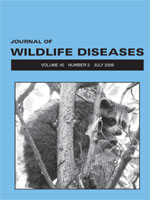The objective of the current study was to elucidate the within-host dynamics of bovine viral diarrhea virus (BVDV) type-1 infection to better understand how this virus could be maintained in white-tailed deer (Odocoileus virginianus, WTD) populations. The BVDV type-1 used in this study was originally isolated from a free-ranging WTD in Indiana. Four fawns were intranasally inoculated with 2 ml BVDV type-1 strain 544 WTD at a 106 tissue culture infectious dose (TCID50)/ml. Two fawns were inoculated with sham inoculum (negative controls). Animals were bled on days −7, 0, 1, 7, and 14 postinoculation (PID) for a complete blood count, chemistry panel, buffy coat (BC), real-time RT-PCR, and virus neutralization (VN). On days 7 and 14 PID, nasal and rectal swabs were obtained for RT-PCR and two of the virus-inoculated fawns and one of the negative controls fawns were euthanized. At necropsy, multiple samples were obtained for histopathology and in situ hybridization (ISH). Quantitative RT-PCR was performed on serum, BC, nasal, and rectal swabs. All animals tested negative for BVDV type 1 neutralizing antibodies on day 0 and animals in the control group remained seronegative throughout the study. No gross lesions were observed at necropsy. BVDV was isolated from lung and pooled lymph nodes from all BVDV-inoculated fawns on days 7 and 14 PID. Infected deer had lymphoid depletion, apoptosis, and lymphoid necrosis in the Peyer’s patches and mesenteric lymph nodes. BVDV was detected in lymphoid tissues of infected animals by ISH. No lesions or virus were identified in control fawns. On day 7 PID, samples from two virus-inoculated fawns were positive for BVDV by virus isolation and RT-PCR from BC and nasal swab samples. One fawn was also positive on a rectal swab. Nasal and rectal swabs from all animals were negative on day 14. Results indicate that infection of WTD with BVDV is possible, and leads to histologic lesions in variety of tissues. In addition, virus shedding into the environment through feces and other secretions is likely.
How to translate text using browser tools
1 July 2009
EXPERIMENTAL INFECTION OF WHITE-TAILED DEER FAWNS (ODOCOILEUS VIRGINIANUS) WITH BOVINE VIRAL DIARRHEA VIRUS TYPE-1 ISOLATED FROM FREE-RANGING WHITE-TAILED DEER
E. A. Raizman,
R. Pogranichniy,
M. Lévy,
M. Negron,
I. Langohr,
W. Van Alstine

Journal of Wildlife Diseases
Vol. 45 • No. 3
July 2009
Vol. 45 • No. 3
July 2009
bovine viral diarrhea virus
BVDV
experimental infection
white-tailed deer




